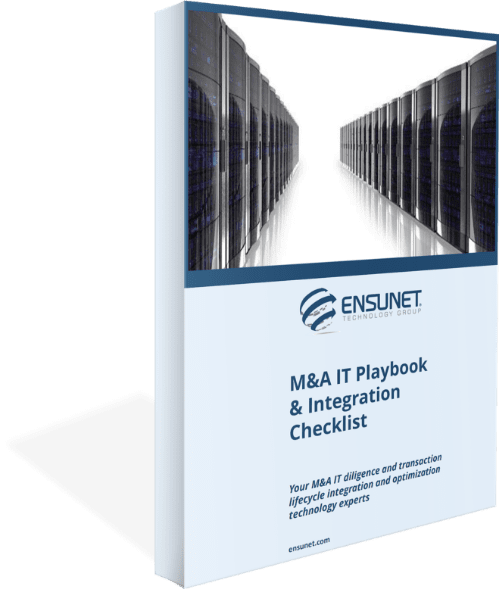M&A IT Playbook & Integration Checklist
Free M&A IT Playbook & Integration Checklist

M&A IT Playbook & Integration Checklist


A cautionary tale from the front lines of Ensunet intervention
Brace yourself. This story may be painful to read.
But you should read it. If you toil in the M&A realm, you need to read it. Because it will show you how easily, quickly, and almost invisibly a well-intentioned enterprise spin-off can spin out of control. Learn from the mistakes of others. Learn why Ensunet continually preaches early intervention for IT. And see how we were able to right this almost-sinking ship before things got even worse.
How’s that for a teaser? Let’s dive into the details of this story.
Greenfield gone wrong
Given all the SNAFUs, we need to be extra delicate here. All we can say is that this involved the divestiture of a huge line of business from a well-known global enterprise. We'll leave it at that. A new enterprise—replete with all its IT—needed to be stood up from scratch, hence the “greenfield” moniker.
The effort was well-intentioned—they always are—but the problems were piling up just below their radar. By the time Ensunet was called in to project-manage the security infrastructure, the initiative was already $25 million over budget. Which is especially poignant, given that the entire original budget was... $25 million.
Who you gonna call?
One of the many roots of the budget-overrun (and deadline-missing) problems was the original approach. The players were using a Scrum/Agile approach, which is good for shifting on the fly—but not so great for delineating a major capital initiative like this. They were trying to track their progress using a 2-D tool that was little better than an Excel spreadsheet. So many of the most basic questions were not being answered... because they’d never been asked in the first place.
Ensunet provided the key program manager for this engagement. He’s a turnaround specialist with a military background; he actually spent years building bridges for the U.S. Army. And nothing could be more appropriate here: He was basically parachuting into a war zone, and absolutely needed to build bridges between teams of of project managers who were being overrun by conflicting priorities and vendors who had grown accustomed to a never-ending flow of purchase orders.
This points up a lesson about enterprise IT that we at Ensunet have been preaching for years: IT is about a lot more than IT. Especially when it pertains to M&A. This is where you need to account for clashing cultures and ways of working; it’s when you need to protect tribal knowledge from walking out the door.
As our program manager put it, this wasn’t like “rebuilding an airplane in flight.” It was more like “trying to save an airplane in flight while it’s on fire, using duct-tape to hold the wings on just so you can land it.”
Start with the basics
You might think that the challenges here were overwhelming. But for Ensunet’s seasoned “recovery” pro, it was just another day at the office. The first order of business was imposing order on all this chaos.
This meant starting with the basics. It meant going back to the source material, such as the master services agreement and its addenda. It meant drawing up a charter, using tried-and-true project-management best practice, to define the project scope, including what needed to be done, who needed to do it, what it would cost, who would report to whom, what the escalation plan was, and so on.
This involved diving into those glorified spreadsheets and culling out the important data. It required the creation of a resource-allocation diagram.
And it involved some colorful conversations with corporate stakeholders.
A negotiating act
There were about ten different business-unit stakeholders at play here. The first thing we asked them was to list their three-to-five top “success points”—things that they would consider to be crucial for the project.
Do you think they all aligned? Of course not. But that’s typical. Our next job was to negotiate to create alignment and consensus. Then we were able to instruct the beleaguered project managers so they could actually, finally, project-manage.
Not that this was easy. The global footprint of the enterprise required geographic scrutiny of rules and regulations. You may have heard of GDPR, the European law that sets strict rules for online privacy. That seemed to be the high-water mark for this project—until an even stricter law (New York State’s DFS-500) superseded it.
Getting into the weeds
So what were some of those “success points” that the stakeholders so eagerly sought? Here are some of the issues we addressed and helped to get back on track:
Righting the ship
Getting back to basics got the program back on track. No, we couldn’t recoup the $25 million that had already been over-spent. But we did see that new deadlines were set, and met. Lines of responsibility were established. Swim-lanes were defined. The spigot of limitless purchase orders was shut off. And we did all this in less than two months.
As we’d mentioned at the outset, this is a cautionary tale. As our project manager put it, it would’ve been better if we’d been called in months earlier. Imagine the millions that could’ve been saved.
Ensunet has supported IT for billions in pre- and post-merger activity. If you need help with this crucial challenge, download our free M&A IT Playbook & Integration Checklist. Or contact us today for a no-obligation consultation with one of our friendly subject—matter experts.
Reach out to the world’s most reliable IT services.